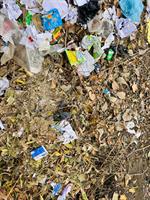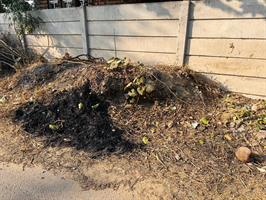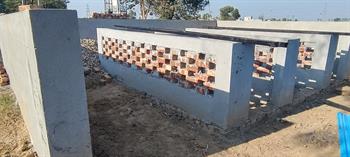- Language
- Submit your story
- DONATE NOW
STORY PREVIEW
segregation wastes pit
Satya Bharti School Dyalgarh
Punjab
MENTOR
Neetu Singh


1. Improper Waste Management: • Littering, lack of proper bins, and no segregation of waste lead to pollution and an unhygienic environment. 2. Water Scarcity or Pollution: • Limited access to clean drinking water or polluted water sources affect health and daily life. 3. Lack of Greenery or Deforestation: • Fewer trees and green spaces reduce air quality, increase heat, and negatively impact biodiversity.
Improper waste disposal not only pollutes the environment but also creates health hazards like the spread of diseases due to pests and stagnant garbage. It affects the cleanliness of schools and neighborhoods, reduces the quality of life, and harms local ecosystems. Addressing this issue can lead to a cleaner, healthier, and more sustainable community. Moreover, raising awareness about waste segregation and recycling can instill lifelong habits in students and residents, creating a ripple effect of positive change.
People Affected by Improper Waste Management: 1. Students and Teachers in Schools: • Concerns: • Unhygienic conditions affecting health and attendance. • Foul smell and litter disrupting the learning environment. • Lack of awareness among children about proper waste disposal. 2. Residents of the Neighborhood: • Concerns: • Increased pests like flies, mosquitoes, and rodents spreading diseases. • Pollution of nearby water sources due to waste runoff. • A decline in property value and quality of life due to dirty surroundings. 3. Farmers and Local Workers: • Concerns: • Waste affecting soil fertility and crops if dumped improperly. • Reduced agricultural productivity from plastic and hazardous waste contamination. 4. Community at Large: • Concerns: • Long-term environmental damage, such as soil and water pollution. • Loss of resources that could be recycled or reused. • The high cost of waste cleanup and management.

1. Awareness Campaigns: • Organize workshops, rallies, and competitions in schools to teach the importance of waste segregation and recycling. • Use posters, street plays, and social media to spread awareness in the community. 2. Setting Up Waste Segregation Systems: • Install color-coded bins (green for organic, blue for recyclable, and red for hazardous waste) in schools and public areas. • Provide clear instructions for proper segregation. 3. Composting Organic Waste: • Create compost pits in schools and communities to recycle biodegradable waste into organic manure. • Use the manure for gardening or distribute it to local farmers. 4. Recycling Drives: • Partner with recycling centers to collect and process plastic, paper, and metal waste. • Organize periodic collection drives to encourage participation. 5. Community Clean-Up Programs: • Conduct regular clean-up drives with the involvement of students, teachers, and residents. • Promote volunteerism to maintain a clean environment. 6. Penalties for Littering: • Introduce fines or warnings for improper waste disposal in the community to discourage bad habits. 7. Collaboration with Local Authorities: • Work with the municipality to ensure timely waste collection and proper disposal facilities. • Advocate for improved infrastructure, like composting units or recycling plants. 8. Incentive Programs: • Reward households, schools, or businesses for proper waste segregation and disposal. • Provide discounts or coupons for using recycled materials. 9. School-Community Partnerships: • Use schools as centers for change by involving students in leading waste management projects in their neighborhoods. 10. Eco-Friendly Practices: • Encourage the reduction of waste by avoiding single-use plastics and promoting reusable items like cloth bags and bottles.
1. Feasibility: Installing color-coded bins is cost-effective and easy to implement in schools and neighborhoods. It provides a clear, practical method to begin segregating waste at the source. 2. Immediate Impact: Proper segregation reduces littering, makes waste easier to manage, and ensures recyclable materials are not wasted. 3. Environmental Benefits: Composting biodegradable waste produces organic manure, which can improve soil fertility and reduce the need for chemical fertilizers. 4. Educational Value: Introducing these systems in schools educates students on sustainable practices, encouraging them to adopt eco-friendly habits for life. 5. Community Involvement: This solution actively involves students, teachers, and residents, fostering teamwork and accountability.

Planning and Setup: • Identify locations for placing color-coded bins and a compost pit in schools and the community. • Procure bins for organic, recyclable, and hazardous waste and set up a composting unit. 2. Awareness Campaign: • Conduct sessions for students, teachers, and residents on waste segregation and composting benefits. • Use posters, charts, and demonstrations to explain the process. 3. Implementation: • Place bins in designated areas and label them clearly. • Encourage everyone to separate waste at the source and dispose of it in the appropriate bins. 4. Monitoring and Maintenance: • Assign teams (students and community volunteers) to monitor bin usage and ensure segregation is followed. • Collect organic waste regularly and process it in the compost pit. 5. Utilization and Feedback: • Use compost in school gardens or distribute it to farmers.
1. Cleaner Environment: • The school and neighborhood became cleaner as waste was segregated and disposed of properly, reducing litter and pollution. 2. Increased Awareness: • Students, teachers, and residents gained a better understanding of waste segregation, composting, and recycling. Many adopted eco-friendly habits at home. 3. Compost Production: • Organic waste from the school and community was turned into compost, which was used in school gardens and distributed to farmers, promoting sustainable farming. 4. Reduced Waste Volume: • Segregation reduced the amount of waste sent to landfills, with recyclable and organic waste being reused effectively. 5. Community Engagement: • The project fostered teamwork among students, teachers, and residents, creating a sense of pride and responsibility in maintaining cleanliness. 6. Replicable Model: • Neighboring schools and communities expressed interest in replicating the waste segregation system after seeing its success.
30
1. School Principal: “This project has transformed our school environment. Students are now actively participating in keeping the campus clean and learning valuable lessons about sustainability. It’s inspiring to see them lead by example.” 2. Local Resident: “Earlier, waste was scattered everywhere, attracting pests and creating a foul smell. Now, with proper bins and composting, our neighborhood looks much cleaner, and we feel proud to contribute to this change.
1. Lack of Initial Awareness: • Challenge: Many people, especially students and some residents, were unaware of the importance of waste segregation and composting. • Solution: We conducted awareness sessions and workshops for both students and the community, explaining the environmental and health benefits of proper waste management. Visual aids like posters and demonstrations were also used to simplify the process. 2. Reluctance to Change Habits: • Challenge: Some community members were resistant to change and continued to dispose of waste improperly. • Solution: We implemented a reminder system by placing clear, labeled bins and regularly educating people through follow-up sessions. Engaging students as ambassadors of change helped spread the message more effectively. 3. Inconsistent Waste Collection and Composting: • Challenge: At times, there were delays in collecting segregated waste or maintaining the compost pit due to limited resources. • Solution: We formed a volunteer group of students and community members who took turns overseeing the waste collection and composting process. Regular monitoring and organizing clean-up drives ensured the system ran smoothly. 4. Insufficient Infrastructure: • Challenge: Initially, the composting area and bins were not sufficient for the volume of waste generated. • Solution: We gradually expanded the number of bins and compost pits, ensuring they were placed at strategic locations. We also worked with local authorities to improve waste management infrastructure.
MORE THAN 30 DAYS
Sustainable cities and communities
I believe these challenges and solutions highlight the real-world complexities of implementing waste management projects in communities. The key to success lies in overcoming resistance to change and ensuring consistent education and involvement. By addressing issues like awareness, habit change, infrastructure, and resource limitations, the project became more sustainable. Engaging people through regular follow-up and community participation helped build a sense of ownership, making it easier to maintain the positive impact over time. This approach not only addressed the immediate problem but also laid the foundation for long-term behavioral change.

1. School Sharing: • The project was introduced during school assemblies, where I explained the importance of waste segregation and composting. • I shared details through classroom sessions and interactive workshops for students and teachers. Students also created posters and presentations to spread awareness further. • Response: Teachers and students were enthusiastic and actively participated in the waste segregation process. Many students took the knowledge home and encouraged their families to adopt the same practices. 2. Community Sharing: • I held meetings with local residents and organized a community event to showcase the waste segregation bins and composting pits. • Posters and leaflets were distributed in the neighborhood, explaining how to segregate waste and the benefits of composting. • Response: The community showed a positive response, with many residents appreciating the project. Some were initially hesitant but gradually adopted the practice after seeing its effectiveness in the school and the neighborhood.
20-50
1. Regular Awareness Campaigns: • Continue periodic workshops, assemblies, and community meetings to refresh knowledge and motivate ongoing participation. 2. Monitoring and Maintenance: • Set up a monitoring team of students, teachers, and local volunteers to ensure the segregation bins and compost pits are regularly maintained and emptied. 3. Incentive Programs: • Introduce small rewards or recognition for households and schools that consistently follow the waste segregation process, encouraging long-term participation. 4. Partnership with Local Authorities: • Work with local municipal authorities to ensure waste management infrastructure is supported and that the community continues to receive adequate waste disposal services. 5. Incorporating into School Curriculum: • Integrate waste management and sustainability topics into school curricula, ensuring that future generations remain informed and engaged.



















